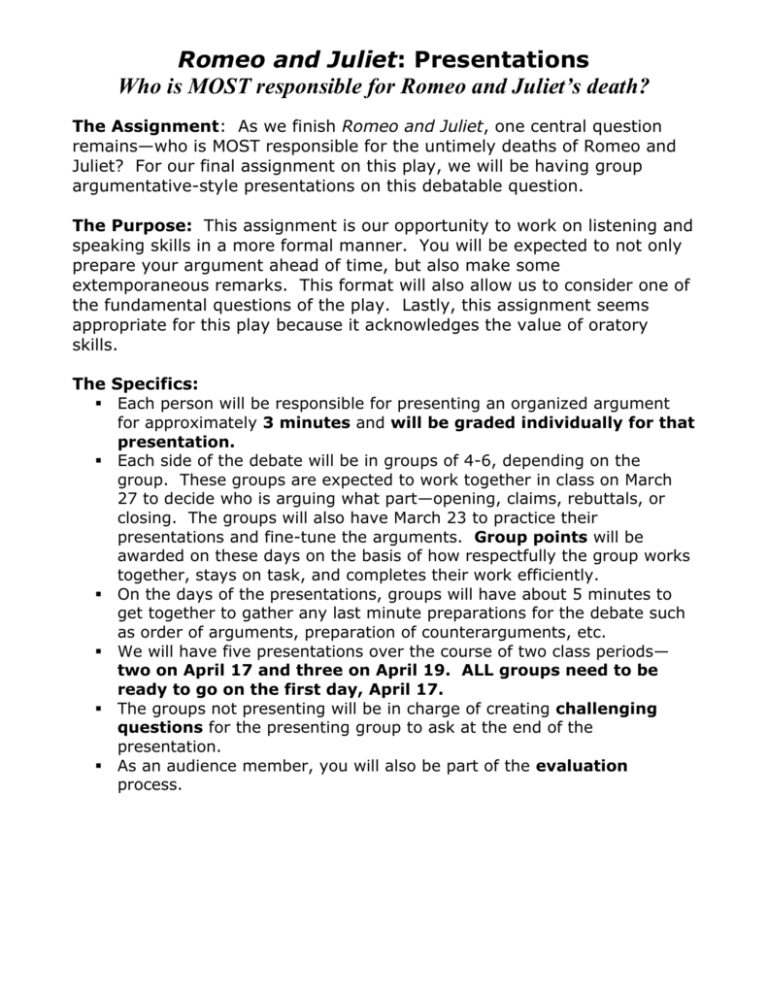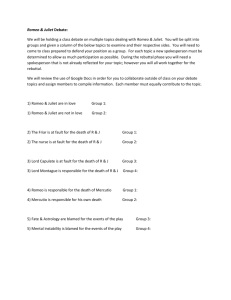Romeo and Juliet Debate - Moreau Catholic High School MOODLE
advertisement

Romeo and Juliet: Presentations Who is MOST responsible for Romeo and Juliet’s death? The Assignment: As we finish Romeo and Juliet, one central question remains—who is MOST responsible for the untimely deaths of Romeo and Juliet? For our final assignment on this play, we will be having group argumentative-style presentations on this debatable question. The Purpose: This assignment is our opportunity to work on listening and speaking skills in a more formal manner. You will be expected to not only prepare your argument ahead of time, but also make some extemporaneous remarks. This format will also allow us to consider one of the fundamental questions of the play. Lastly, this assignment seems appropriate for this play because it acknowledges the value of oratory skills. The Specifics: Each person will be responsible for presenting an organized argument for approximately 3 minutes and will be graded individually for that presentation. Each side of the debate will be in groups of 4-6, depending on the group. These groups are expected to work together in class on March 27 to decide who is arguing what part—opening, claims, rebuttals, or closing. The groups will also have March 23 to practice their presentations and fine-tune the arguments. Group points will be awarded on these days on the basis of how respectfully the group works together, stays on task, and completes their work efficiently. On the days of the presentations, groups will have about 5 minutes to get together to gather any last minute preparations for the debate such as order of arguments, preparation of counterarguments, etc. We will have five presentations over the course of two class periods— two on April 17 and three on April 19. ALL groups need to be ready to go on the first day, April 17. The groups not presenting will be in charge of creating challenging questions for the presenting group to ask at the end of the presentation. As an audience member, you will also be part of the evaluation process. The Due Dates: Due April 11: Preparation form for presentation due. Time in class will be allotted for working with group on strategies, claims, and prep for presentation. Due April 15: “Dress rehearsal”—Completed, printed copy of entire presentation ready to practice with group. Due April 17: Presentation day 1. All students need to be prepared to go. Due April 19: Presentation day 2. Due March 20 (Green and Gold Day): Reflection due from day 2 The Point Value: 100 points of presentations. Preparation form: 10 points “Dress Rehearsal” speech: 15 points Group grade: 10 points presentation grade: 50 points DueIndividual 4/8 or 4/9: Reflection due from day 2 presentation students. Presentation Evaluator: 15 points The Arguments for the Presentations: Group 1: The Nurse is most responsible for the deaths of Romeo and Juliet. Group 2: The Parents are most responsible for the deaths of Romeo and Juliet. Group 3: Friar Lawrence is most responsible for the deaths of Romeo and Juliet. Group 4: Romeo and Juliet themselves are most responsible for their deaths. Group 5: Tybalt is most responsible for the deaths of Romeo and Juliet. (Period 4) The Format of the Presentation: (3 minutes each) 1. Opening Argument 2. Claim One 3. Claim Two (if applicable) 4. Rebuttal One 5. Rebuttal Two (if applicable) 6. Closing Argument Speaker’s Roles in the Debate Opening Arguments (one presenter): The first person to speak will need to lay out the overall argument of the presentation, the main points to be discussed, and what is at stake here in the argument. The first speaker helps define the issue and sets up the questions of responsibility. You will need to make specific references to the play through your summary of the background of the issue, in the form of direct quotes, but with a wider, sweeping scope that captures the attention of the audience and sets up the position taken by the team. Claim Arguments (one or two presenters): The team will need to choose the two most important arguments that support the overall position—then a student is assigned each main claim or argument. Each argument needs to have at least TWO pieces of evidence, in the form of direct quotations from the play, to support them. As always, please be sure to introduce and contextualize your quotations, as well as cite the page number, along with act, scene and line numbers (the audience will be following along). Your commentary is analysis that helps to prove your point and should follow general expectations of commentary, such as avoiding speculation, personal feelings, generic or repetitive comments, etc. Rebuttals/Counter-arguments (one to two presenters): A good argument anticipates the objections to the points, so the team will need to consider what these arguments might be and be prepared to acknowledge and then rebut them. You will look at the possible opposing viewpoints to your team’s claims, anticipate these objections, and be prepared to offer a clear answer for them using evidence to back it up. Just like a claim, a rebuttal needs to have at least TWO pieces of evidence, in the form of direct quotations from the play, to support them. As always, please be sure to introduce and contextualize your quotations, as well as cite the page number, along with act, scene and line numbers. Analysis follows the same expectations as for claims. Closing Arguments (one presenter): The final points made by team needs to pull the argument together in a cohesive fashion. Because of the nature of the presentation, some recapping of the major arguments might be necessary, but more importantly the closing arguments need to show the connections and relationships between the points. In other words, don’t just summarize, but use all the main claims and rebuttals to convince the audience of your position. Also, this would be an opportunity to rebut any arguments made that have not been addressed. The closing argument also needs to have at least two direct quotes as support for the overall position that really capture the heart of the argument. *Please note that you all must use DIFFERENT CDs; no overlap! Reminders for Oral Presentations 1. Know your material thoroughly. Put what you have to say in a logical sequence. Ensure your presentation will be captivating to your audience as well as worth their time and attention. Practice and rehearse your speech at home or where you can be at ease and comfortable, in front of a mirror, your family, or friends. Use a tape-recorder and listen to yourself. 2. When you are presenting in front of an audience, you are performing as an actor is on stage. How you are being perceived is very important. Dress appropriately for the occasion. Present the desired image to your audience. Look pleasant, enthusiastic, confident, proud, but not arrogant. Remain calm. Appear relaxed, even if you feel nervous. 3. Speak slowly, enunciate clearly, and show appropriate emotion, feeling and tone relating to your topic. Speak to the person farthest away from you to ensure your voice is loud enough to project to the back of the room. Vary the tone of your voice and dramatize if necessary. 4. Body language is important. Standing, walking or moving about with appropriate hand gesture or facial expression is preferred to sitting down or standing still with head down and reading from a prepared speech. 5. Speak with conviction as if you really believe in what you are saying. Persuade your audience effectively. The material you present orally should have the same ingredients as that which are required for a written paper, i.e. a logical progression from INTRODUCTION (set up) to EVIDENCE (supporting quotations) to ANALYSIS (your commentary) to CONCLUSION (wrap it up effectively). 6. Do not read from notes for any extended length of time although it is quite acceptable to glance at your notes infrequently. Speak loudly and clearly. Sound confident. Do not mumble. If you made an error, correct it, and continue. No need to make excuses or apologize profusely. 7. Maintain sincere eye contact with your audience. Use the 3-second method, e.g. look straight into the eyes of a person in the audience for 3 seconds at a time. Have direct eye contact with a number of people in the audience, and every now and then glance at the whole audience while speaking. Use your eye contact to make everyone in your audience feel involved. Don’t look just at me! 8. Remember that communication is the key to a successful presentation. If you are short of time, know what can be safely left out. If you have extra time, know what could be effectively added. Always be prepared for the unexpected. 9. Pause. Allow yourself and your audience a little time to reflect and think. Don't race through your presentation and leave your audience, as well as yourself, feeling out of breath. 10. End your presentation with an interesting remark or an appropriate final thought. Leave your listeners with a positive impression and a sense of completion. Thank your audience and sit down.






